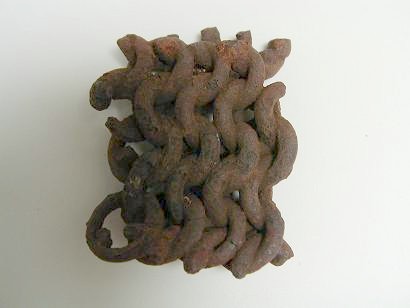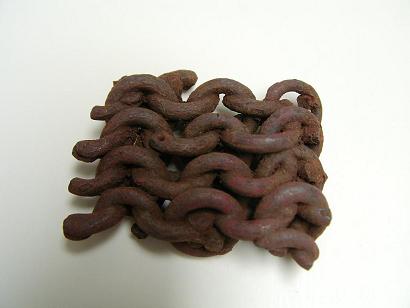|
Date Acquired
|
2005 |
|
Location Discovered |
Vienna area |
| Material
|
Iron |
|
Dimensions |
4.0cm long x 3.5cm wide
Ring wire thickness: 2mm
Outer diameter: 10.5mm
Inner diameter: 6.5mm
VERY TINY rivets |
| Possibly Roman Empire |
1st to 6th
Century AD |
|
Description |
|
Iron mail or
possible lorica hamata fragment.
This fragment
however
has none of the known characteristics of Roman mail, which doesn't mean it
can't be Roman, but rather that there's no reason to believe it is.
The fragment does not appear to have any welded rings. The one that
has a clear rivet hole in it is no different than the others where just
the seam is visible, and the tiny size of the rivet makes recognizing them
very difficult. No rivet heads are clear anywhere. And the
fact is that Roman mail isn't alternating riveted/welded rings, it's
riveted/solid punched rings. There are definitely no solid punched
rings in the fragment.
Mail was originally of Celtic origin, however
adapted by the Romans and improved upon. Instead of continuous rows of
rings each "welded" together, there were alternating rows, one being
riveted the other not. This added greater strength and ease of repair to
the whole armor.
As lorica
segmentata came into mainstream use mail or lorica hamata began to
be phased out. It was expensive to make and had some distinct
disadvantages for protection over the new plate armor. By the late
3rd Century however Mail made a comeback and again became the mainstay
form or armor. It is unknown why this occurred, but probably had to
do with the fact that Lorica Segmentata was too complicated to make by
that later more chaotic period. (1)(2)(3)(4)
-painting by John Warry
Click on
Pictures for higher resolution
 Reverse View |

Close up View |
| 